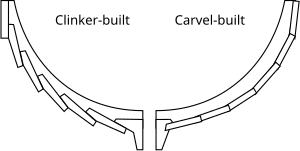
Back Buc llis Catalan کارڤێڵ (بەلەمسازی) CKB Kravelbygning Danish Kraweelbeplankung German Casco liso Spanish Kravelli Finnish Bordages à franc-bord French Carvel (bangunan kapal) ID Gangenbouw Dutch Kravell NN
This article needs additional citations for verification. (May 2017) |

Carvel built or carvel planking is a method of boat building in which hull planks are laid edge to edge and fastened to a robust frame, thereby forming a smooth surface. Traditionally the planks are neither attached to, nor slotted into, each other, having only a caulking sealant between the planks to keep water out. Modern carvel builders may attach the planks to each other with glues and fixings.[1] It is a "frame first" method of hull construction, where the shape is determined by the framework onto which the planks are fixed. This is in contrast to "plank first" or "shell first" methods, where the outer skin of the hull is made and then reinforced by the insertion of timbers that are fitted to that shape.[2] The most common modern "plank first" method is clinker construction; in the classical period "plank first" involved joining the edges of planks with mortise and tenon joints within the thickness of the timbers, superficially giving the smooth-hull appearance of carvel construction, but achieved by entirely different means.
Compared to clinker-built hulls, carvel construction allowed larger ships to be built. This is because the fastenings of a clinker hull took all the hogging and sagging forces imposed by the ship moving through large waves. In carvel construction, these forces are also taken by the edge-to-edge contact of the hull planks.
- ^ Carvel Planking Texts for Sailboats—Richard Joyce Montana Tech
- ^ McGrail, Seán (September 2015). "Hornell, Hasslöf and Boatbuilding Sequences: HORNELL, HASSLÖF AND BOATBUILDING SEQUENCES". International Journal of Nautical Archaeology. 44 (2): 382–387. doi:10.1111/1095-9270.12116. S2CID 161168797.
© MMXXIII Rich X Search. We shall prevail. All rights reserved. Rich X Search